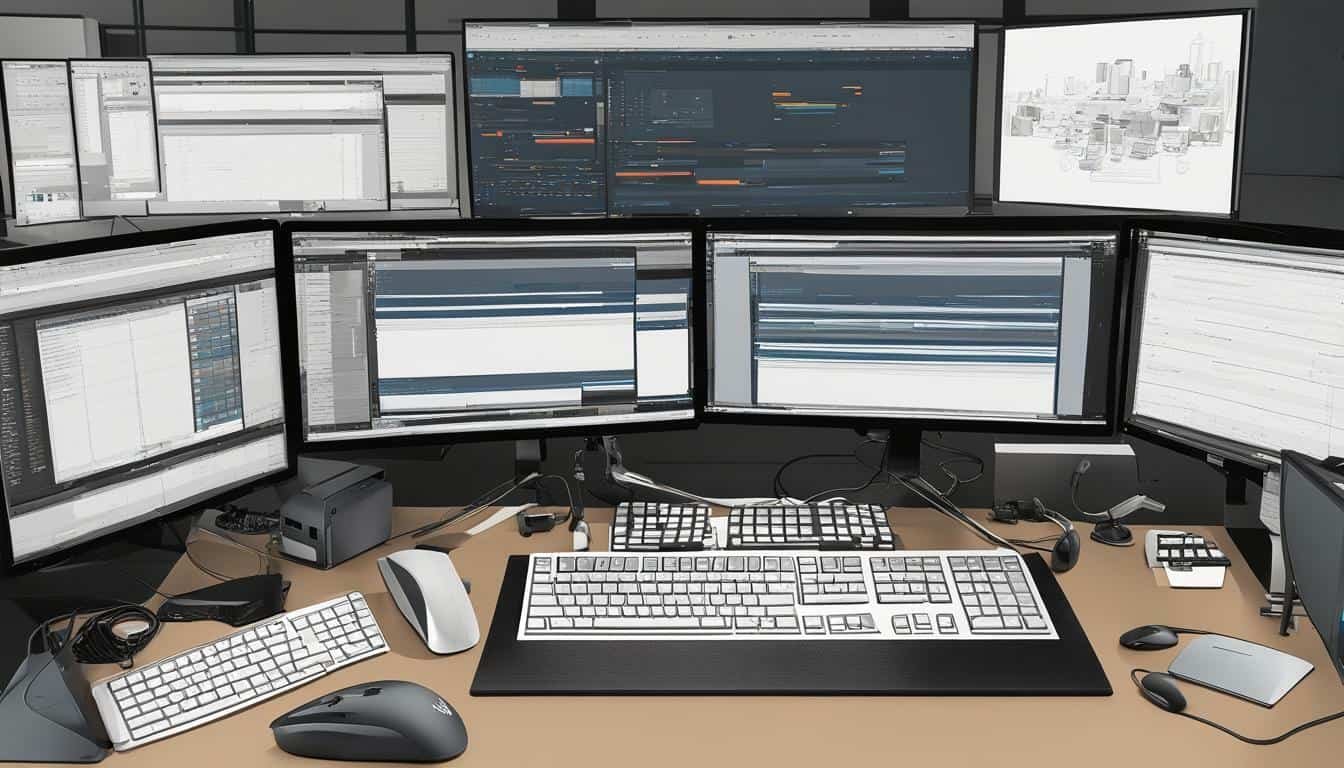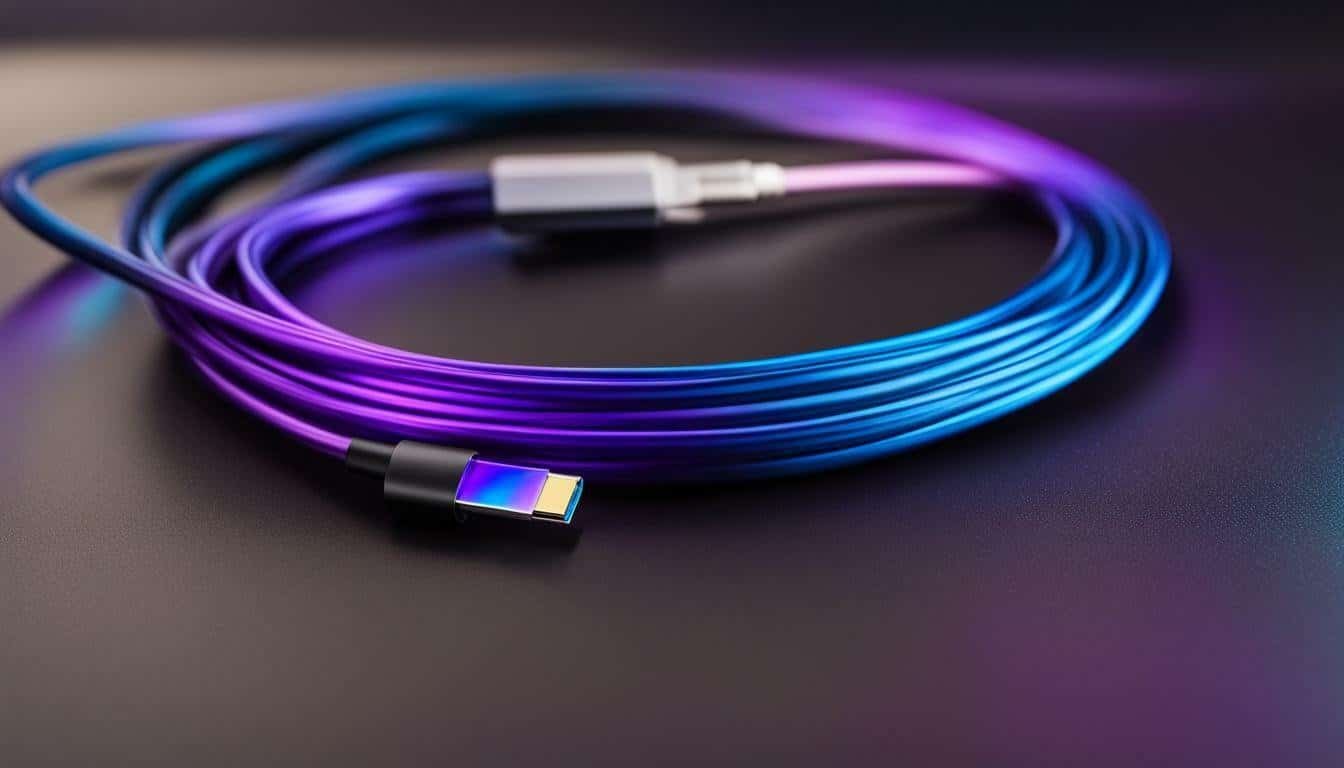As a professional who needs to juggle multiple computers or devices, you know how tricky it can be to switch between them – especially if they have different operating systems or peripherals. This is where KVM switches come in, allowing you to control each device from a single set of keyboard, video, and mouse (KVM) peripherals. In this article, I will explain what KVM switches are, how they work, and what to consider when selecting and installing one to simplify your workspace.
Key Takeaways:
- KVM switches allow you to control multiple computers or devices from a single set of peripherals.
- There are different types of KVM switches, including desktop, rack-mounted, and IP-based switches.
- Features to consider when selecting a KVM switch include hotkey switching, USB peripheral sharing, and video quality.
- Compatibility is an important factor to consider, including the types of video connectors supported and compatibility with different operating systems and devices.
- Installing a KVM switch involves connecting computers and peripherals, and troubleshooting tips are available for common issues.
What is a KVM Switch?
If you have multiple computers or devices in your workspace, switching between them can be a hassle. A KVM switch can simplify your workspace by allowing you to control multiple devices with a single keyboard, mouse, and monitor.
A KVM switch stands for Keyboard, Video, and Mouse switch. Essentially, it is a hardware device that allows you to switch between multiple computers or devices using the same keyboard, mouse, and monitor. This means you don’t have to constantly unplug and replug peripherals into different machines.
| Key Features: | Benefits: |
|---|---|
| Hardware device | Eliminates the need for multiple keyboards and mice in your workspace. |
| Switch between devices | Allows you to easily switch between multiple devices without unplugging and replugging peripherals. |
| Single set of peripherals | Reduces clutter and simplifies your workspace with a single set of peripherals. |
Some KVM switches also allow you to share USB peripherals and audio devices between computers. This means you can easily connect a printer, scanner, or other peripheral to any computer in your setup.
KVM switches are available in a variety of sizes and configurations to meet different needs. Whether you have two or more computers, or need to switch between devices in a server room or data center, there is a KVM switch that can simplify your workspace.
Benefits of Using a KVM Switch
Using a KVM switch can bring numerous benefits to your workspace setup. Here are some reasons why you should consider incorporating a KVM switch:
- Enhanced productivity: With a KVM switch, you can control multiple computers or devices with a single set of peripheral devices. This means you can seamlessly switch between different systems without the need to physically disconnect and reconnect cables, saving time and effort.
- Cost-effective: Instead of purchasing separate sets of peripherals for each computer or device, a KVM switch allows you to share a single set of peripherals among multiple systems. This can save you money while also reducing clutter on your desk.
- Space-saving: As mentioned, a KVM switch can help you reduce cable clutter on your desk, but it can also help you save space. You can reduce the number of monitors, keyboards, and mice on your desk, freeing up more space for work.
- Increased security: By using a KVM switch to connect multiple systems, you can reduce the number of physical points of access to sensitive information. This enhances security by reducing the risk of unauthorized access to your data.
- Flexible workspace setup: A KVM switch allows you to use multiple systems with a single workstation setup. This can prove beneficial for professionals who need to switch between different systems frequently, such as programmers, designers, and system administrators.
Overall, a KVM switch can bring significant advantages to your workspace, including increased productivity, reduced costs, and enhanced security. With its space-saving and flexible features, a KVM switch can be a valuable addition to any professional workspace.
How Does a KVM Switch Work?
A KVM switch is a device that allows you to connect multiple computers or devices to a single set of peripheral devices, such as a keyboard, mouse, and monitor. But how does it actually work?
When a KVM switch is installed, it acts as a central hub that connects all of the computers or devices to the peripheral devices. The hub then uses advanced circuitry to allow the user to control each device seamlessly.
Switching Methods
There are several methods that a KVM switch can use to switch between connected devices:
| Switching Method | Description |
|---|---|
| Button Switching | A physical button on the KVM switch is used to manually switch between devices. |
| Hotkey Switching | A keyboard shortcut is used to switch between devices. |
| Automatic Scanning | The KVM switch automatically scans and switches between devices at set intervals. |
No matter the switching method, the KVM switch ensures that the user can easily control all devices connected to it without the need for multiple sets of peripheral devices.
Peripheral Sharing
In addition to allowing control of multiple devices, many KVM switches also feature peripheral sharing. This means that the peripheral devices connected to the switch, such as the keyboard and mouse, can be shared between the connected devices. This saves valuable desk space and eliminates clutter caused by multiple sets of peripheral devices.
Overall, the advanced circuitry and switching capabilities of a KVM switch make it a valuable tool for anyone who needs to control multiple computers or devices from a single set of peripheral devices, simplifying and streamlining their workspace.
Types of KVM Switches
When it comes to KVM switches, there are several types available on the market. Depending on your needs, you can choose from desktop KVM switches, rack-mounted KVM switches, or IP-based KVM switches. Each type of KVM switch has its own set of advantages and disadvantages.
| Desktop KVM Switches | Rack-mounted KVM Switches | IP-based KVM Switches |
|---|---|---|
| Designed for use in small workspaces | Mounted directly onto a server rack | Allows remote access and control over the internet |
| Usually support only a few computers | Can support a large number of computers | May require additional setup and configuration |
| Easy to install and use | Requires technical expertise to install and configure | Less secure than other types of KVM switches |
Desktop KVM switches are a good option for small workspaces with a limited number of computers. They are easy to set up and use, but may not have the same level of functionality as other types of KVM switches. Rack-mounted KVM switches, on the other hand, are designed for larger server rooms and can support a large number of computers. However, they require technical expertise to install and configure.
Finally, IP-based KVM switches allow remote access and control over the internet. This is a useful feature for IT professionals who need to manage multiple servers located in different locations. However, they may require additional setup and configuration, and may not be as secure as other types of KVM switches.
Features of KVM Switches
When selecting a KVM switch, there are various features and functionalities to consider that will affect its performance and compatibility with your workspace setup. Here are some key features to keep in mind:
| Feature | Description |
|---|---|
| Hotkey switching | Allows for quick switching between connected devices using customizable keyboard shortcuts. |
| USB peripheral sharing | Allows multiple computers to share USB peripherals, such as printers, scanners, and external hard drives. |
| Video quality | Determines the resolution and clarity of the video transmitted from the connected devices, with higher quality video requiring more bandwidth. |
| Audio support | Enables audio to be transmitted from the connected devices to the output display or speakers. |
| Remote access | Allows for remote control and access of connected devices through an IP-based KVM switch or software application. |
It’s important to assess your specific needs and requirements to determine which features will be most beneficial for your workspace setup. For example, if your work involves graphic design or video editing, prioritizing high-quality video transmission may be crucial. On the other hand, if you frequently need to access computers remotely, a KVM switch with remote access capabilities may be more appropriate.
Choosing the Right KVM Switch
When deciding which KVM switch is right for you, there are several factors to consider to ensure compatibility and functionality with your specific needs. Here are some key considerations:
- Number of Ports: Determine how many computers or devices you will need to control and choose a KVM switch with enough ports to accommodate them all.
- Video Resolution Support: If you require high-definition video quality, ensure the KVM switch you select supports the appropriate video resolution.
- Compatibility with Operating Systems: Verify that the KVM switch supports the operating systems of the devices you wish to control.
- USB Peripheral Sharing: Consider whether you need to share USB peripherals, such as printers or scanners, between the connected devices.
- Hotkey Switching: Determine if the KVM switch provides hotkey switching, allowing quick and easy switching between devices with a simple keyboard shortcut.
By keeping these factors in mind, you can select a KVM switch that seamlessly integrates with your setup and simplifies your workspace.
Installation Process of KVM Switches
Once you have chosen the right KVM switch for your workspace, the next step is to install and set it up. Here’s a step-by-step guide to help you:
- Turn off all computers and devices that will be connected to the KVM switch.
- Connect the KVM switch to each computer or device using the appropriate cables. Make sure to connect the keyboard, mouse, and monitor cables to the designated ports on the KVM switch.
- Connect the peripheral devices, such as printers and scanners, to the KVM switch using the appropriate USB or audio cables.
- Connect the power adapter to the KVM switch and plug it into a power outlet.
- Turn on all computers and devices.
- Press the hotkey sequence to switch between computers or use the switch button on the KVM switch to select the desired device.
It’s important to note that some KVM switches may require additional software or drivers to be installed on your computers or devices. Be sure to check the manufacturer’s instructions and download any necessary software before completing the installation process.
Compatibility of KVM Switches
When using a KVM switch, it is essential to ensure that it is compatible with all the devices and peripherals you want to connect to it. This includes the operating system, video connectors, and USB devices.
Firstly, the KVM switch must be compatible with the operating systems of all the computers that will be connected to it. This means that it must support Windows, Mac, Linux, or any other operating system your devices may be running. It is crucial to check the compatibility list provided by the manufacturer before purchasing a KVM switch.
Secondly, the KVM switch must support the video connectors used by your computers or devices. Some common video connectors include HDMI, VGA, and DVI. Ensure the KVM switch supports the video resolution required by your devices for optimal performance.
Thirdly, if you plan to connect USB devices to the KVM switch, ensure that it has USB peripheral sharing functionality, allowing multiple computers to share the same USB devices. This feature will eliminate the need to unplug and plug in USB devices repeatedly when switching between computers.
Finally, it is important to check if the KVM switch is compatible with any additional devices or peripherals you plan on using, such as printers or scanners. This will ensure that all of your devices work efficiently with the KVM switch and eliminate any compatibility issues.
Troubleshooting KVM Switches
Using a KVM switch can greatly simplify your workspace, but sometimes issues can arise. Here are some common problems you might encounter and what you can do to fix them.
Keyboard and Mouse Not Working
If your keyboard and mouse are not working, ensure they are plugged into the correct ports on the KVM switch and that the switch is powered on. If that doesn’t work, try restarting the switch or the connected computers. It’s also possible that the keyboard or mouse is incompatible with the switch, so check for compatibility before purchasing.
Video Quality Issues
If you are experiencing poor video quality, check that the video cables are securely connected and not damaged. Also make sure the correct video resolution settings are configured on both the switch and the connected computers. If you are still experiencing issues, try using shorter video cables or reducing the distance between the switch and the computers.
Audio Not Working
If audio is not working, ensure the audio cable is securely connected and that the audio settings on the connected computers are correctly configured. You may also need to adjust the audio settings on the KVM switch itself.
USB Devices Not Recognized
If your USB devices are not recognized, check that they are plugged into the correct ports on the KVM switch and that the switch is powered on. Make sure you are using compatible USB devices and that the correct USB drivers are installed on the connected computers.
If you encounter other issues with your KVM switch, consult the user manual for troubleshooting tips or contact the manufacturer’s customer support for assistance. With a little troubleshooting, you can get your KVM switch working smoothly and enjoy the benefits of a simplified workspace.
Conclusion
In conclusion, KVM switches are a valuable tool for simplifying your workspace and increasing productivity. By allowing a single set of peripheral devices to control multiple computers or devices, KVM switches eliminate the need for multiple keyboards, mice, and monitors, which can quickly clutter up your desk and cause confusion.
When choosing a KVM switch, it’s important to consider factors such as the number of ports, video resolution support, and compatibility with different operating systems and devices. By selecting the right KVM switch for your needs, you can ensure seamless operation and optimal performance.
If you experience any issues with your KVM switch, it may be due to compatibility or connection problems. However, many common issues can be resolved through basic troubleshooting techniques, such as resetting the switch or checking cables and connections.
Overall, a KVM switch can simplify your workspace and streamline your workflow, allowing you to focus on the task at hand and maximize productivity. Whether you’re a business owner, IT professional, or casual user, incorporating a KVM switch into your setup is a smart investment that can pay dividends in the long run.
How Can a KVM Switch Help in Managing Dual Monitors?
A KVM switch is an effective tool for managing dual monitors efficiently. The best kvm switch for dual monitors allows you to control multiple computers from a single set of peripherals. This eliminates the hassle of constantly switching cables and provides a seamless experience. With just a push of a button, you can effortlessly switch between the two monitors, enhancing productivity and organization.
FAQ
Q: What is a KVM switch?
A: A KVM switch, short for Keyboard, Video, and Mouse switch, is a hardware device that allows you to control multiple computers or devices using a single set of peripheral devices, such as keyboard, monitor, and mouse.
Q: What are the benefits of using a KVM switch?
A: Using a KVM switch offers several benefits, including reducing clutter on your workspace by eliminating the need for multiple sets of peripheral devices, improving productivity by allowing you to switch between computers quickly, and saving money by not having to purchase individual sets of peripherals for each computer.
Q: How does a KVM switch work?
A: A KVM switch works by connecting the peripheral devices, such as keyboard, monitor, and mouse, to the KVM switch, which is then connected to the computers or devices. With the press of a button or a hotkey combination, you can switch control between the connected computers or devices.
Q: What are the different types of KVM switches?
A: There are various types of KVM switches available, including desktop KVM switches that are suitable for small setups, rack-mounted KVM switches that can be installed in server cabinets, and IP-based KVM switches that enable remote control over the internet.
Q: What features should I consider when choosing a KVM switch?
A: When selecting a KVM switch, consider features such as hotkey switching for convenient control, USB peripheral sharing for device compatibility, and video quality for optimal display output.
Q: How do I choose the right KVM switch?
A: Factors to consider when choosing a KVM switch include the number of ports required to connect all your devices, video resolution support to ensure compatibility with your monitors, and compatibility with different operating systems used by your computers.
Q: What is the installation process for KVM switches?
A: The installation process of a KVM switch involves connecting the peripheral devices to the KVM switch, connecting the KVM switch to the computers or devices, and configuring any necessary settings using the provided instructions.
Q: What compatibility considerations should I keep in mind when using a KVM switch?
A: When using a KVM switch, ensure compatibility with your devices by checking the types of video connectors supported by the switch and verifying compatibility with the operating systems and devices you intend to connect.
Q: How can I troubleshoot issues with my KVM switch?
A: If you encounter problems with your KVM switch, try troubleshooting steps such as checking cable connections, restarting the connected computers, or updating the firmware of the KVM switch. Refer to the manufacturer’s documentation for specific troubleshooting guidance.

![Top & Best Processors For Hacking: [High-Performance CPUs]](https://nondevelopers.com/wp-content/uploads/2023/06/Best-Processors-for-hacking.jpg)


0 Comments